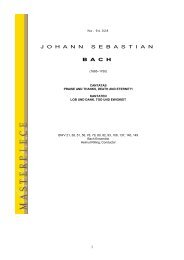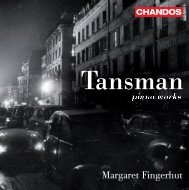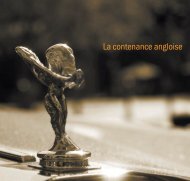gyri gyri gaga - Naxos Music Library
gyri gyri gaga - Naxos Music Library
gyri gyri gaga - Naxos Music Library
Erfolgreiche ePaper selbst erstellen
Machen Sie aus Ihren PDF Publikationen ein blätterbares Flipbook mit unserer einzigartigen Google optimierten e-Paper Software.
with musicians together in cheerful company,<br />
and with each voice allocated its own popular<br />
song. Although compositions of this type were<br />
already known in earlier centuries, the idea was<br />
first used in a song collection printed in 1544.<br />
At this date, the publisher Wolfgang Schmeltzl<br />
was a schoolmaster in the Viennese Schottenstift,<br />
but had the collection entitled Guter, seltzamer,<br />
und künstreicher Gesang (Good, curious and<br />
artistic Songs) printed in Nuremberg. In this can<br />
be found our recorded Quodlibet by Mathias<br />
Greiter (c. 1494-1550), which assembles four<br />
melodies in four voices: „Ach Elslein“, but also<br />
„Es taget vor dem Walde“ (Day breaks before the<br />
wood) and „Greiner, Zanker“ (Whiner, Squabbler)<br />
were popular songs at the time. Greiter makes<br />
use of this demanding compositional technique<br />
adopting a trick, for although the bass leads<br />
with the text „Greiner, Zanker“, this is a freely<br />
composed part, which does not follow the melody<br />
associated with the text. Besides the Quodlibet as<br />
we understand it today Schmeltzl indicated with<br />
this concept pieces which are known today as<br />
catalogue songs. An example is the satirical song<br />
Von Narren (of fools), which lists in an almost<br />
endless sequence every conceivable variation<br />
of a fool in a malicious declamation. The song<br />
collection also gives, with Das erst Fewr bewaren<br />
(Hietz Feur!) (The first fire protection - Watch the<br />
fire!) by Leonhardt Päminger (1495-1567), an<br />
important living glimpse into the urban sound<br />
picture of early modern times, with the call of the<br />
nightwatchman embodied in a song. The triadic<br />
nature of the melody reminds us of the sound of<br />
a signal horn, which the nightwatchman carries to<br />
support his cry and to raise the alarm in case of<br />
fire in the town.<br />
A particularly large repertoire of songs was printed<br />
for the doctor and composer Georg Forster. He<br />
himself had received a musical education in the<br />
Heidelberg court chapel, and he had settled down<br />
in Nuremberg after studies in various German<br />
towns. From 1539 to 1556 he published altogether<br />
five books of songs, which were repeatedly<br />
reprinted, each time with a specific arrangement<br />
as to the contents. In the second book, which<br />
appeared in Nuremberg in 1540, and was entitled<br />
Der andre Theil, kurtzweiliger guter frischer<br />
teutscher Liedlein, zu singen vast lustig (Another<br />
part of entertaining good new German Ditties, to<br />
be sung very cheerfully), there are collected all the<br />
drinking and feasting songs to do with the Feast of<br />
Saint Martin (11 th November), for which a goose<br />
is traditionally served. At the same time, there is a<br />
series of satirical songs with erotic allusions, like<br />
Es hett ein Biederman ein Weib (An honest man<br />
had a wife) by Senfl, and the anonymous Tritt<br />
auf den Riegel von der Tür (Tread open the bolt),<br />
which both tell about unfaithful wives. A popular<br />
description of an amorous adventure by partners<br />
of different status is the „grasen“, which is used<br />
in Isaac‘s Es wollt ein Mägdlein grasen gan (A<br />
maiden wanted to go to the grass). In the same<br />
book can also be found Ist keiner hie, der spricht<br />
zu mir? (Is there no one here who will speak to<br />
me?), in which onomatopoeic syllables and the<br />
repetition of short sections depict the sweaty and<br />
happy atmosphere of the inn, and Der Pfarrer<br />
von St. Veit (The Vicar of St Veit), in which he is<br />
accused of a liaison with his beautiful cook. But<br />
also a harmless dance-like folk song such as Drei<br />
Laub auf einer Linden (Three leaves on a lime-tree)<br />
by Johann Leonhard of Langenau (1515-1534)<br />
could delight the purchaser of this songbook.<br />
12
















